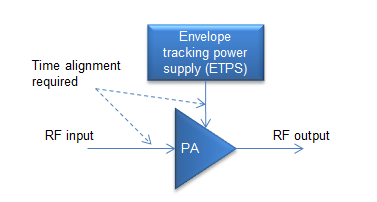
Envelope tracking is a technology to improve the efficiency level of the PA (power amplifier). It allows the power supply of the PA to be dynamically controlled by the envelope of the RF signal passing through the PA to increase the system efficiency.
Reasons to Use Envelope Tracking
Envelope Tracking Basic Concept
For conventional PA, the power supply is designed to be a fixed DC voltage as shown in Figure 1.This kind of design has high transmitter efficiency for systems like GSM and GPRS, which use constant-envelope GMSK modulation.

Figure 1. Conventional PA block diagram
With the pursuit of increased data throughput in limited radio frequency bandwidth, higher spectral efficiency is required. To achieve this, in modern communication systems, more complicated modulation and access schemes are used, like OFDM, CDMA. In these modulation schemes, the signal envelope varies continuously during the transmission. Figure 2 shows that the LTE signal envelope varies over time. If in this case, the PA still works under constant power supply, it means a loss of efficiency, as the PA is the most efficient at its peak power. At lower power levels, the PA operates below its peak power. As a result, a significant amount of power is dissipated as heat.

Figure 2. Constant power supply for variable envelope
The consequence of the PA inefficiency is very practical. The smart phones will be hotter and their batteries will run out quickly; at the same time, mobile and broadcast network operators need to pay a lot for the wasted energy.
Envelope tracking, is a technique to increase the PA efficiency dramatically.
The basic principle of envelope tracking, as shown in Figure 3, is to constantly adjust the supply voltage of the PA according to the envelope of RF input signal so that the PA can always operate at a high efficiency.

Figure 3. Variable power supply for variable envelope
Figure 4 illustrates the envelope tracking PA block diagram. In baseband, envelope detector generates envelope by taking magnitude of IQ, which is . The magnitude of the signal is not the ideal signal for envelope tracking power supply. To obtain the maximum efficiency, the magnitude of the signal is often modified by shaping. A shaping table is then developed to map the signal magnitude to the required voltage supply on the PA. This shaping table determines characteristics of ET system, so system designers spend a lot of time and effort to optimize shaping tables. The shaped envelope is then supplied to Envelope Tracking Power Supply, or ETPS.

Figure 4. Envelope tracking PA
For envelope tracking PA, the envelope tracking power supply and the RF input signal should be aligned strictly in time. Even small time deviations will have substantial influence in the RF output signal, leading to the deterioration of the ACP and EVM.

Figure 5. Time Alignment